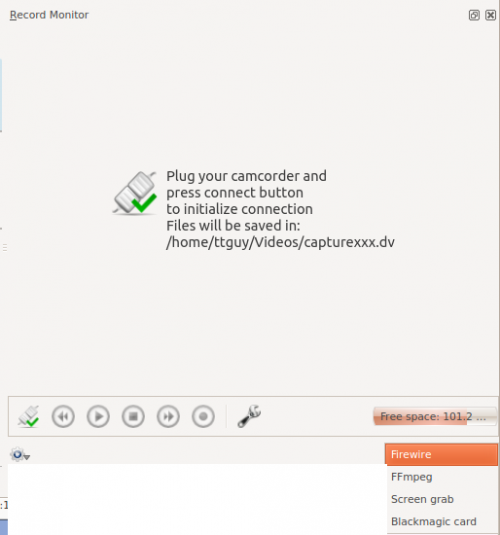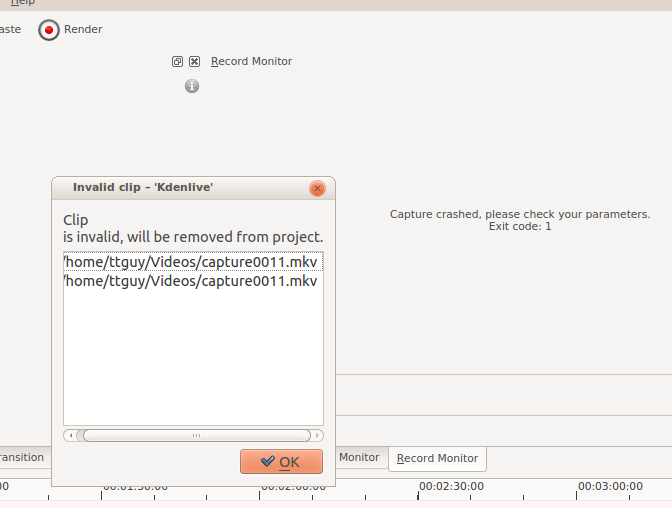Kdenlive/Manual/Capturing: Difference between revisions
(Marked this version for translation) |
No edit summary |
||
| (16 intermediate revisions by 7 users not shown) | |||
| Line 1: | Line 1: | ||
<languages/> | <languages/> | ||
<translate> | <translate> | ||
== Capturing == <!--T:1--> | == Capturing Video == <!--T:1--> | ||
{{Note|At least Firewire and webcam capture were removed in porting to KDE 5 due to lack of manpower.}} | |||
<!--T:2--> | <!--T:2--> | ||
'''Kdenlive''' provides functionality for capturing video from external devices | '''Kdenlive''' provides functionality for capturing video from external devices; e.g., Firewire, FFmpeg, Screen Grab and Blackmagic. | ||
<!--T:3--> | <!--T:3--> | ||
| Line 10: | Line 11: | ||
<!--T:4--> | <!--T:4--> | ||
You define the location your captures | You define the destination location for your captures by using <menuchoice>Settings -> Configure Kdenlive -> Environment -> Default Folders</menuchoice> (more on this [[Special:myLanguage/Kdenlive/Manual/Settings_Menu/Configure_Kdenlive#Default_Folders|here]]). | ||
<!--T:5--> | <!--T:5--> | ||
To execute a video capture select the [[Special:myLanguage/Kdenlive/Manual/Monitors#Record_Monitor|Record Monitor]] and choose the capture device from the | To execute a video capture, select the [[Special:myLanguage/Kdenlive/Manual/Monitors#Record_Monitor|Record Monitor]] and choose the capture device from the dropdown in the bottom right. | ||
<!--T:6--> | <!--T:6--> | ||
| Line 19: | Line 20: | ||
=== Firewire === <!--T:7--> | === Firewire === <!--T:7--> | ||
<!--T:34--> | |||
This option is not available in recent versions of Kdenlive. Use dvgrab directly in a terminal to capture video from firewire. | |||
<!--T:8--> | <!--T:8--> | ||
This captures video from sources connected via a firewire (also known as - IEEE 1394 High Speed Serial Bus) card and cable. | This captures video from sources connected via a firewire (also known as - IEEE 1394 High Speed Serial Bus) card and cable. This functionality uses the [http://linux.die.net/man/1/dvgrab dvgrab] program and the settings for this can be customized by clicking the spanner icon or choosing <menuchoice>Settings>Configure Kdenlive</menuchoice>. See [[Kdenlive/Manual/Settings_Menu/Configure_Kdenlive#Configure_Firewire_Capture|Configure Firewire Capture]]. | ||
<!--T:30--> | |||
To perform a capture: | |||
<!--T: | <!--T:31--> | ||
* Plug in your device to the firewire card and turn it on to play mode | |||
<!--T: | <!--T:35--> | ||
* | * Click the ''Connect Button'' [[File:Kdenlive Connect firewire button.png]] | ||
<!--T:36--> | |||
* Click the Record Button — note it toggles to grey while you are recording | |||
<!--T: | <!--T:37--> | ||
* Click the Record button again to stop capture. Or click the stop button. | |||
<!--T: | <!--T:38--> | ||
* Once capturing is finished, click the disconnect button [[File:Kdenlive Disconnect capture.png]] | |||
<!--T: | <!--T:39--> | ||
* In the ''Captured Files'' dialog, click the import button to have the captured files automatically imported into the project bin. | |||
<!--T: | <!--T:32--> | ||
[[File:Kdenlive Captured files dialog.png]] | |||
<!--T: | <!--T:33--> | ||
{{Note|If your device does not start playing the source device when you click the record button, you may have to start playback on your device manually and then click record.}} | |||
=== FFmpeg === <!--T:9--> | === FFmpeg === <!--T:9--> | ||
<!--T:10--> | <!--T:10--> | ||
I believe this captures video from an installed Web Cam using Video4Linux2. | I believe this captures video from an installed Web Cam using ''Video4Linux2''. | ||
=== Screen Grab === <!--T:11--> | === Screen Grab === <!--T:11--> | ||
<!--T:16--> | <!--T:16--> | ||
This captures video of the PC screen. In version 0.9.2 it uses recordMyDesktop to do the capture. There is an open defect with this functionality in ver 0.9.2 | This captures video of the PC screen. In version 0.9.2 it uses ''recordMyDesktop'' to do the capture. There is an open defect with this functionality in ver 0.9.2 — See bug tracker ID [http://www.kdenlive.org/mantis/view.php?id=2643 2643]. | ||
<!--T:24--> | <!--T:24--> | ||
In version 0.9.3 the | In version 0.9.3, the screen grab is done by the ''ffmpeg'' functionality instead. For screen capture to work in ver 0.9.3, the version of ''ffmpeg'' installed needs to have been compiled with the <code>--enable-x11grab</code> option. Ubuntu comes with an ''ffmpeg'' version compiled with this option. | ||
<!--T:25--> | <!--T:25--> | ||
To check on your linux distro type | To check on your linux distro, type <code>ffmpeg -version</code> in a terminal and look for <code>--enable-x11grab</code> in the reported configuration info. <ref>There are now two branches of ''ffmpeg'': a ''Libav'' branch and an ffmpeg.org branch. The ''ffmpeg'' version from the latter branch reports the configuration when you run with <code>ffmpeg -version</code>. The ''Libav'' version does not. So this method to check for the <code>--enable-x11grab</code> does not work if you have the ''Libav'' version of ''ffmpe''g.</ref> | ||
<!--T:26--> | <!--T:26--> | ||
If you are capturing screen and using the X246 with audio settings and you get a crash as shown in the screen shot ... | If you are capturing the screen and using the X246 with audio settings and you get a crash as shown in the screen shot ... | ||
<!--T:27--> | <!--T:27--> | ||
| Line 71: | Line 77: | ||
<!--T:28--> | <!--T:28--> | ||
... then consider creating a profile for audio capture where | ... then consider creating a profile for audio capture where <code>-acodec pcm_s16le</code> is replaced by <code>-acodec libvorbis -b 320k</code>. See [[Special:myLanguage/Kdenlive/Manual/Settings_Menu/Configure_Kdenlive#Capture|Configure Kdenlive]]. | ||
=== Blackmagic === <!--T:12--> | === Blackmagic === <!--T:12--> | ||
| Line 83: | Line 89: | ||
<!--T:14--> | <!--T:14--> | ||
{{Prevnext2 | {{Prevnext2 | ||
| prevpage=Special:MyLanguage/Kdenlive/Manual/Project_Menu/Render/Render_Profile_Parameters | nextpage=Special:MyLanguage/Kdenlive/Manual/ | | prevpage=Special:MyLanguage/Kdenlive/Manual/Project_Menu/Render/Render_Profile_Parameters | nextpage=Special:MyLanguage/Kdenlive/Manual/CapturingAudio | ||
| prevtext=Render Profile Parameters | nexttext= | | prevtext=Render Profile Parameters | nexttext=Capturing Audio (Dubbing) | ||
| index=Special:MyLanguage/Kdenlive/Manual | indextext=Back to menu | | index=Special:MyLanguage/Kdenlive/Manual | indextext=Back to menu | ||
}} | }} | ||
Latest revision as of 23:12, 18 February 2021
Capturing Video
Kdenlive provides functionality for capturing video from external devices; e.g., Firewire, FFmpeg, Screen Grab and Blackmagic.
You configure video capturing from (more on this here).
You define the destination location for your captures by using (more on this here).
To execute a video capture, select the Record Monitor and choose the capture device from the dropdown in the bottom right.
Firewire
This option is not available in recent versions of Kdenlive. Use dvgrab directly in a terminal to capture video from firewire.
This captures video from sources connected via a firewire (also known as - IEEE 1394 High Speed Serial Bus) card and cable. This functionality uses the dvgrab program and the settings for this can be customized by clicking the spanner icon or choosing . See Configure Firewire Capture.
To perform a capture:
- Plug in your device to the firewire card and turn it on to play mode
- Click the Record Button — note it toggles to grey while you are recording
- Click the Record button again to stop capture. Or click the stop button.
- In the Captured Files dialog, click the import button to have the captured files automatically imported into the project bin.
FFmpeg
I believe this captures video from an installed Web Cam using Video4Linux2.
Screen Grab
This captures video of the PC screen. In version 0.9.2 it uses recordMyDesktop to do the capture. There is an open defect with this functionality in ver 0.9.2 — See bug tracker ID 2643.
In version 0.9.3, the screen grab is done by the ffmpeg functionality instead. For screen capture to work in ver 0.9.3, the version of ffmpeg installed needs to have been compiled with the --enable-x11grab option. Ubuntu comes with an ffmpeg version compiled with this option.
To check on your linux distro, type ffmpeg -version in a terminal and look for --enable-x11grab in the reported configuration info. [1]
If you are capturing the screen and using the X246 with audio settings and you get a crash as shown in the screen shot ...
... then consider creating a profile for audio capture where -acodec pcm_s16le is replaced by -acodec libvorbis -b 320k. See Configure Kdenlive.
Blackmagic
This is for capturing from Blackmagics decklink video capture cards (AFAIK). Not sure how stable this code is at the moment. See defect 2130.
Footnotes
- ↑ There are now two branches of ffmpeg: a Libav branch and an ffmpeg.org branch. The ffmpeg version from the latter branch reports the configuration when you run with
ffmpeg -version. The Libav version does not. So this method to check for the--enable-x11grabdoes not work if you have the Libav version of ffmpeg.




